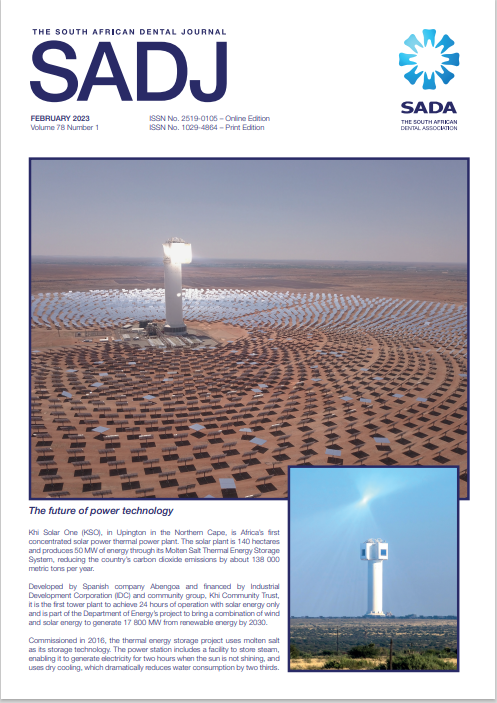Surveillance of specific pathogens on mobile phones in aerosol and non-aerosol generating dental clinics during the COVID pandemic
DOI:
https://doi.org/10.17159/sadj.v78i01.15748Keywords:
Mobile phones in dental clinics; Pathogens on mobile phones; COVID-19 mobile phone protocols; phone clinical use; phone hygiene practices; mobile phone use guidelines.Abstract
Following COVID-19 protocols implemented globally, it is prudent to extend this to mobile phones, regarded as carriers of microbes, as these are used extensively in clinical settings for learning and patient care. Was to determine types of microbes harbored on mobile
phones and related hygiene practices whilst using these in aerosol and non-aerosol generating dental settings. This cross-sectional study was conducted in two parts: A laboratory study to determine the prevalence of microbes on mobile phones and a questionnaire survey to determine the related knowledge and behavior of phone users in both aerosol and non-aerosol generating dental clinics. All proper protocols (consent, ethics) were adhered to. A small percentage (27.2%) of swabs of mobile phones yielded a positive bacterial culture, of these 72% were from the AGP dental setting. Gram positive and negative microorganisms were distinguishable, indicating a diverse group of microbes. Students and staff indicated good mobile phone hygiene practices, but there is place for improvement.
Their related knowledge of disinfectants and use were acceptable, but not having mobile phone coverings was problematic.
Faculty protocols for disinfecting mobile phones and standardized guidelines for its use in aerosol or non-aerosoclinics is recommended.
Downloads
References
Fedena. What is the impact of mobile device on student learning? Foradian techonologies. 2019. Availablefrom:https://fedena.com/blog /2019/ 02/ what -is the-impact-of-mobile -device-on-student-learning.html
Olsen M, Campos M, Lohning A, et al., Mobile phones represent a pathway for microbial transmission: A scoping review. Travel Med Infect Dis. 2020 May;35:101704. DOI: https://doi.org/10.1016/j.tmaid.2020.101704
Panigrahi SK, Pathak VK, Kumar MM, Raj U, P KP. Covid-19 and mobile phone hygiene in healthcare settings. BMJ Glob Health. 2020 Apr;5(4):2505. Available from: /pmc/articles/PMC7204931/ DOI: https://doi.org/10.1136/bmjgh-2020-002505
Sánchez Espinoza EP, Farrel MC, Nogueira SV, et al., Are Mobile Phones part of the chain of transmission of SARS-CoV-2 in the hospital? medRx. 2020 Jan;2020.11.02.20224519. Available from: http://medrxiv.org/content/ early/2020/11/04/2020.11.02.20224519.abstract
Meek A. Touching these 7 things could give you COVID-19. BGR MEDIA, LLC. 2020. p. October 20th. Available from: https://bgr.com/science/coronavirus ransmission-touching-surfaces-risk-of-covid-19/
Kampf G, Todt D, Pfaender S, Steinmann E. Persistence of coronaviruses on inanimate surfaces and their inactivation with biocidal agents. J Hosp Infect. 2020 Mar;104(3):246–51. DOI: https://doi.org/10.1016/j.jhin.2020.01.022
Dr. Alexis E. Carrington, Dr. Ayodola Adigun. Smartphones and COVID-19 transmission: What we know so far - ABC News. ABC internet Ventures. 202AD. Available from: https://abcnews.go.com/Health/smartphones-covid-19-transmission/story?id=71778492
Marquès M, Domingo JL. Contamination of inert surfaces by SARS-CoV-2: Persistence, stability and infectivity. A review. Environ Res. 2021 Feb;193:110559. Available from: /pmc/articles/PMC7706414/ DOI: https://doi.org/10.1016/j.envres.2020.110559
Kathree BA, Khan SB, Ahmed R, Maart R, Layloo N, Asia-Micheals W. COVID-19 and its impact in the dental setting: A scoping review. PLoS One. 2020 Dec;15(12). Available from: https://pubmed.ncbi.nlm.nih.gov/33338073/ DOI: https://doi.org/10.1371/journal.pone.0244352
CHITLANGE PR. Short Communication: Contamination of cell phones by pathogenic microorganisms: Comparison between hospital staff and college students. Nusant Biosci. 2014 Jan;6(2). Available from: https://smujo.id/nb/article/view/884 DOI: https://doi.org/10.13057/nusbiosci/n060213
R HF, R HF, M M, MA H. Evaluation of the Cell Phone Microbial Contamination in Dental and Engineering Schools: Effect of Antibacterial Spray. J Epidemiol Glob Health. 2018;8(3–4):143–8. Available from: https://pubmed.ncbi.nlm.nih. DOI: https://doi.org/10.2991/j.jegh.2017.10.004
gov/30864755/
Zoe Moore. How to properly sanitize your cellphone amid coronavirus outbreak | GMA. Good Morning America. 2020. Available from: https://www.goodmorningamerica.com/wellness/story/properly-sanitize-cellphone-amid coronavirus-outbreak-69535459
How To: Disinfect Your Electronics – COVID-19. For Health. 2020. Available from: https://covid-19.forhealth.org/what-you-can-do/how-to-disinfect-your electronics/
COVID-19 National Public Hygiene Strategy and Implementation Plan - July 2020 | Department of Health Knowledge Hub. Available from: https://www.knowledgehub.org.za/elibrary/covid-19-national-public-hygiene-strategy-andimplementation-plan-july-2020
DJ W, H K, WA R. ‘No touch’ technologies for environmental decontamination: focus on ultraviolet devices and hydrogen peroxide systems. Curr Opin Infect Dis. 2016 Aug;29(4):424–31. Available from: https://pubmed.ncbi.nlm.nih.gov/27257798/ DOI: https://doi.org/10.1097/QCO.0000000000000284
Teska P. Portable electronic device management in healthcare. Beckers Healthcare. 2016. Available from:https://www.beckersh ospitalreview.com/healthcare-information-technology/portable-electronic-device-management-inhealthcare.html
Barlean MC, Balcos C, Bobu L, Scutariu MM, Popescu E. Dentists’ Compliance To Hands Hygiene As Method of Health Care Associated Infections Prevention. Rom J Oral Rehabil. 2018;10(1):57–63.
S D, E R, M G, SR AR, CM Z. Legionella in water samples: how can you interpret the results obtained by quantitative PCR? Mol Cell Probes. 2015 Feb;29(1):7–12. Available from: https://pubmed.ncbi.nlm.nih.gov/25241149/ DOI: https://doi.org/10.1016/j.mcp.2014.09.002
World Medical Association Declaration of Helsinki: ethical principles for medical research involving human subjects. JAMA. 2013 Nov;310(20):2191–4. Available from: https://pubmed.ncbi.nlm.nih.gov/24141714/ DOI: https://doi.org/10.1001/jama.2013.281053
BRION M-JA. Essential Epidemiology: An Introduction for students and health professionals. Penny Webb, Chris Bain, Sandy Pirozzo. Cambridge:Cambridge University Press, 2005. £24.99. ISBN 0521546613. Int J Epidemiol. 2006 Apr;35(2):503–4. Available from: https://academic.oup.com/ije/article/35/2/503/694709 DOI: https://doi.org/10.1093/ije/dyi277
Raveendran AV, Jayadevan R Sashidharan S. Long COVID: An overview. Diabetes and Metabolic Syndrome: Clinical Research and Reviews. 2021 15: 869-75 DOI: https://doi.org/10.1016/j.dsx.2021.04.007
Downloads
Published
Issue
Section
License

This work is licensed under a Creative Commons Attribution-NonCommercial 4.0 International License.





.png)